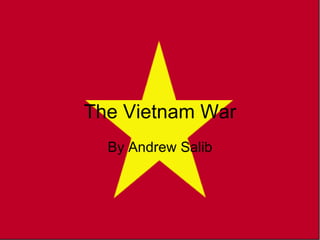The Vietnam War
- 1. The Vietnam War By Andrew Salib
- 2. The Cause As for why the US got involved, Americans feared the "domino theory" of expanding communist empires. The Truman doctrine stated that America would assist governments resisting communism. In 1945, Ho Chi Minh declared Vietnam a free and independent country. However, the British and Chinese helped the French to return and the USA did nothing to stop them.
- 3. The Cause In 1954, after a massive Viet Minh victory over the French at Dien Bien Phu, peace talks were held in Geneva and Vietnam was divided at the 38th parallel. Elections were planned for 1956 but the South Vietnamese leader, Ngo Dinh Diem, refused to hold these. The USA was worried about the spread of Communist power in Asia and Ho Chi Minh was a member of the French Communist Party.
- 4. The Description Gulf of Tonkin Resolution of Aug. 7, 1964: gave President Johnson essentially a free hand to deploy American military forces to Vietnam without Congress' authorization (although it was Congress who passed this resoultion obviously). In essence this was an unofficial declaration of war against North Vietnam and the Vietcong NVA or North Vietnamese Army: the military of North Vietnam which was trying to conquer the South Vietcong: Communist-sympathizers in South Vietnam who often performed guerilla/sabotage/spy operations against American and South Vietnamese forces
- 5. The Description Tet Offensive: During the Buddhist holiday of Tet beginning in late January, 1968, it was assumed that there would be little to no military action taken until the VC, along with elements of the NVA, attacked virtually every city in South Vietnam along with several major American military installations. Though a tactical failure, the reaction by the US media was so depressing and gloomy, that nationwide morale and desire to continue the war sank considerably. This is considered one of the turning points of the war.
- 6. More Events My Lai Massacre: a massacre of South Vietnamese civilians by US troops due to faulty intelligence and a long series of bad choices made by the US commanding officers involved. This was another huge setback for the war back in the US as it happened in the same year as the Tet Offensive, even though it was not revealed for almost two years. Between 300-500 civilians were shot dead by American troops because they believed they were working with the VietCong. The resulting coverup also helped tarnish American reputation in Vietnam and in the world.
- 7. More Events Ho Chi Minh (Trail): Ho Chi Minh was the communist dictator of the North and it was the trail named after him (Ho Chi Minh Trail) which was the primary supply line for NVA and VietCong units operating in the South. Many parts of the trail were hidden by dense jungle, crossed into neighboring Cambodia, or were at times even underground. Nevertheless the US Air Force bombarded the Trail fiercly throughout the war and President Nixon even ordered an invasion of Cambodia specifically to attack the Trail in Cambodian territory.
- 8. 1. The Vietnam War cost the United States 58,000 lives and 350,000 casualties. It also resulted in between one and two million Vietnamese deaths. 2. Congress enacted the War Powers Act in 1973, requiring the president to receive explicit Congressional approval before committing American forces overseas. The Consequences
- 9. The End By Andrew Salib








